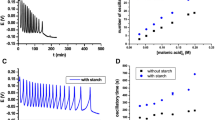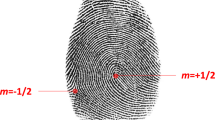Abstract
The results of StepScan DSC obtained for various oxides, chalcogenides, and organic glasses are discussed in connection with the commonly accepted theory of the glass transition. The new experimental features supporting the apparent idea of a reversible equilibrium being a part of the glass transition that is commonly interpreted as purely kinetic-relaxation phenomenon are discussed. Two alternative methods of the description of the reversible part of StepScan DSC record are compared:the empirical one using the exponential-power function [1 − exp(T/T g)n], and the second one based on the van’t Hoff’s equation describing the temperature dependence of equilibrium constant in terms of reaction enthalpy, ΔH. The adequacy of the empirical description is rationalized in the framework of the Tool–Narayanaswamy–Moynihan’s relaxation theory.







Similar content being viewed by others
References
Sipp A, Richet P. Equivalence of volume, enthalpy and viscosity relaxation kinetics in glass-forming silicate liquids. J Non-Cryst Solids. 2002;298:202–12.
Rao KJ. Structural chemistry of glasses. Amsterdam: Elsevier; 2002.
Angell CA, Ngai KL, McKenna GB, McMillan PF, Martin SW. Relaxation in glassforming liquids and amorphous solids. J Appl Phys. 2000;88:3113–57.
Scherer GW. Relaxation in glass and composites. New York: Wiley; 1986.
Scherer GW. Volume relaxation far from equilibrium. J Am Ceram Soc. 1986;69:374–81.
Narayanaswamy OS. A model of structural relaxation in glass. J Am Ceram Soc. 1971;54:491–8.
Tool AQ. Relation between inelastic deformability and thermal expansion of glass in its annealing range. J Res Nat Bur Stand. 1945;34:199–211.
Tool AQ. Relation between inelastic deformability and thermal expansion of glass in its annealing range. J Am Ceram Soc. 1946;29:240–53.
Gutzow I, Schmelzer J. The vitreous state. New York: Springer; 1995.
Cassel B, Scotto P, Sichina B. StepScan DSC: an alternative to the conventional modulated techniques. Perkin Elmer Application Note, PeTech-34.
Kotelnikov GV, Moiseyeva SP, Mezhburd EV. Modulated capillary titration calorimeter. J Therm Anal Calorim. 2008;92:631–4.
Carpenter J, Katayama D, Liu L, Chonkaew W, Menard K. Measurement of tg in lyophilized protein and proteinexcipient mixtures by dynamic mechanical analysis. J Therm Anal Calorim. 2009;95:881–4.
Tsuchiya M. Molar-mass dependence of apparent relaxation time inmelting region of poly(oxytetramethylene)glycol. J Therm Anal Calorim. 2009;97:547–50.
Černošek Z, Holubová J, Černošková E, Liška M. Enthalpic relaxation and the glass transition. J Optoelectron Adv Mater. 2002;4:489–503.
Boolchand P, Georgiev DG, Goodman B. Discovery of the intermediate phase in chalcogenide glasses. J Optoelectron Adv Mater. 2001;3:703–20.
Boolchand P, Georgiev DG, Micoulaut M. Nature of glass transition in chalcogenides. J Optoelectron Adv Mater. 2002;4:823–36.
Cai L, Boolchand P. Nanoscale phase separation of GeS2 glass. Phil Mag. 2002;B82:1649–57.
Holubová J, Černošek Z, Černošková E. Conf. on Non-Crystalline Inorganic Materials 2003, April 8–12, 2003, Bonn, Germany, Book of Abstracts, p. 99.
Holubová J. Thesis, University Pardubice, Pardubice 2004.
Chromčíková M, Holubová J, Liška M, Černošek Z, Černošková E. Modeling of the reversible part of StepScan DSC measurement of the glass transition. Ceramics. 2005;49:91–6.
Atkins PW. Physical chemistry. 3rd ed. New York: W.H. Freeman Comp; 1986. p. 221–4.
Holubová J, Černošek Z, Černošková E, Liška M. Isothermal structural relaxation: temperature and time dependencies of relaxation parameters. J Non-Cryst Solids. 2003;326 & 327:135–40.
Certificate of Viscosity Values, Standard Sample No. 711 Lead-Silica Glass, U.S. Department of Commerce, National Bureau of Standards, Washington, D.C. 20235.
Acknowledgements
This study was supported by Ministry of Education of the Slovak Republik under the grant AV 4/0025/07, and the Slovak Grant Agency for Science under the grant VEGA 1/0330/09.
Author information
Authors and Affiliations
Corresponding author
Rights and permissions
About this article
Cite this article
Liška, M., Černošek, Z., Chromčíková, M. et al. New features of the glass transition revealed by the StepScan® DSC. J Therm Anal Calorim 101, 189–194 (2010). https://doi.org/10.1007/s10973-009-0625-z
Received:
Accepted:
Published:
Issue Date:
DOI: https://doi.org/10.1007/s10973-009-0625-z




